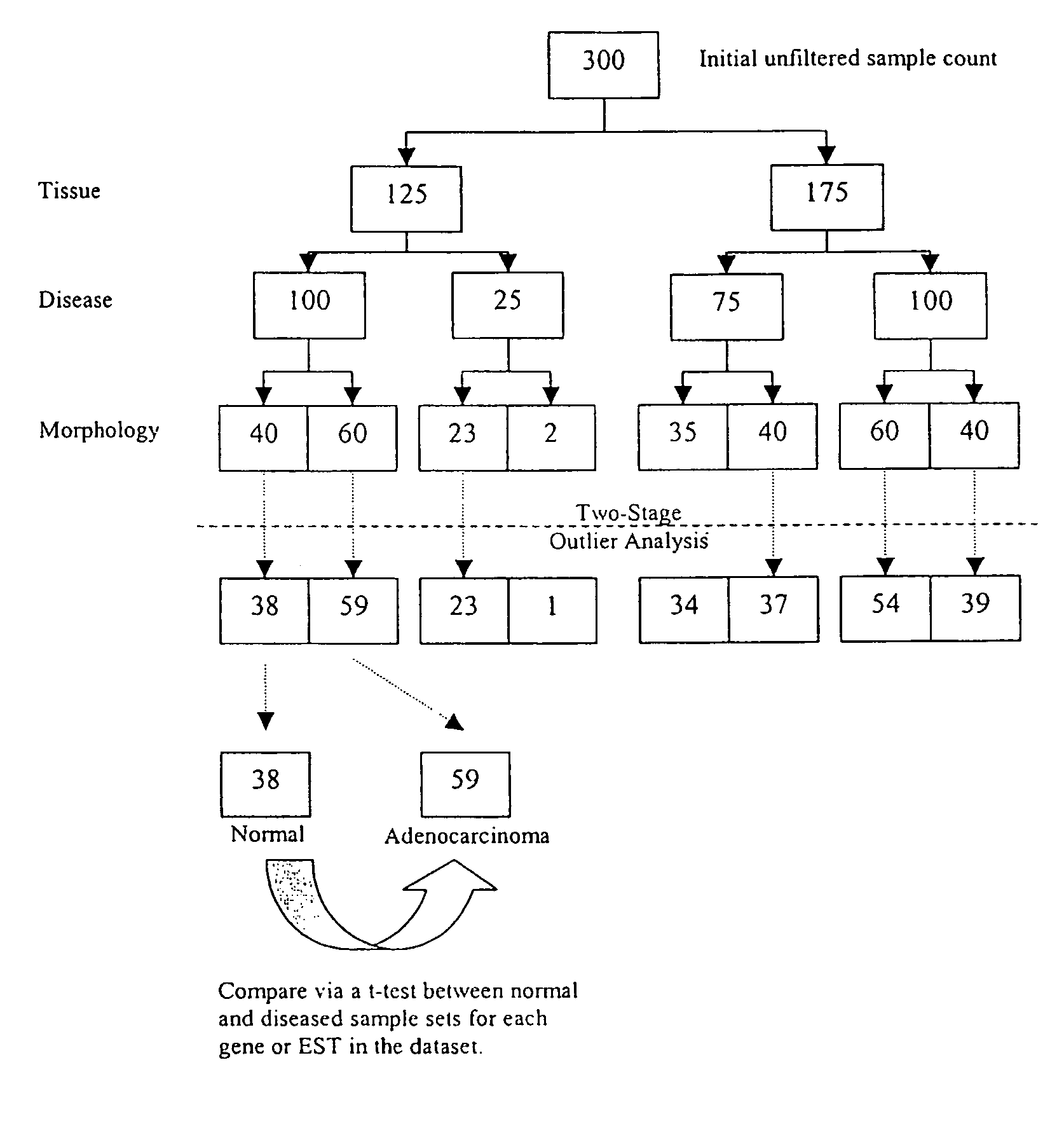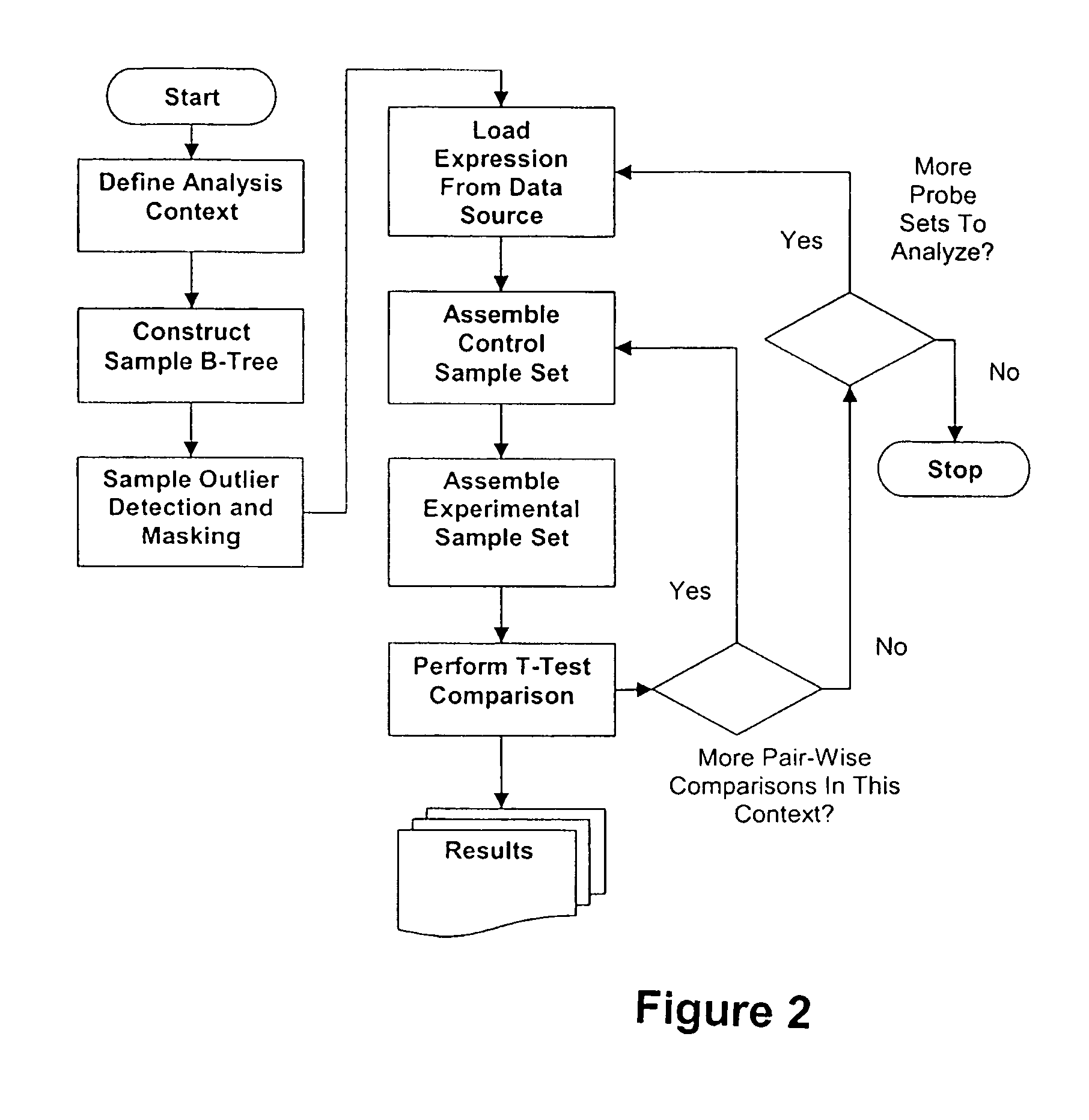System and method for determining matching patterns within gene expression data
a gene expression and matching technology, applied in the field of biological data systems and methods, can solve the problems of slow computational response time, undiscovered potential interesting patterns, and large volume of data, and achieve the effect of slowing down the computational response time and avoiding the accumulation of data
- Summary
- Abstract
- Description
- Claims
- Application Information
AI Technical Summary
Benefits of technology
Problems solved by technology
Method used
Image
Examples
example 1
Human Breast Tissue
[0127]Normal
[0128]Infiltrating Ductal Carcinoma (all stages and receptor parameters)[0129]Infiltrating Ductal Carcinoma Stage TIN0M (all receptor parameters)[0130]Infiltrating Ductal Carcinoma Stage T1N+M (all receptor parameters.)[0131]Etc.[0132]Infiltrating Ductal Carcinoma ER+, PR+, Her2+(all stages)[0133]Infiltrating Ductal Carcinoma ER+, PR+, Her2− (all stages)[0134]Etc.[0135]Infiltrating Ductal Carcinoma, Smoking (all stages & receptor parameters)[0136]Infiltrating Ductal Carcinoma, Non-Smoking (all stages & receptor params.)[0137]Etc.
example 2
Human Kidney Tissue
[0138]Normal
[0139]Primary Malignancy, Clear Cell Carcinoma
[0140]Etc.
[0141]Secondary Malignancy from Liver Primary
[0142]Secondary Malignancy from Ovary Primary
[0143]Etc.
The sample nodes are selected to be as “granular” as possible as long as they make pathological and biological sense. The following is a exemplary, non-exhaustive list of the classes of sample nodes that can be generated.
[0144]1. Normal human, rat and mouse tissue morphology nodes.[0145]2. All available human, rat and mouse-derived untreated cell lines.[0146]3. All available human, rat and mouse-derived compound-treated cell lines.[0147]4. Specific disease human, rat and mouse morphology nodes.[0148]5. Grouped as a function of tissue, disease, morphology.[0149]6. Grouped as a function of staged disease where applicable.[0150]7. Grouped as a function of a basic disease-specific clinical parameter where appropriate, e.g., receptor status in breast cancer tissue.[0151]8. Grouped as a parameter of prima...
example 3
Match / X Analysis
[0275]The Match / X algorithm was applied to identify genes that have coordinate or inverse coordinate gene expression patterns relative to CDC2. CDC2 is a key regulator of the cell cycle that is a therapeutic target for drugs designed to eliminate rapidly proliferating cells, such as those found in malignant tumors.
[0276]A gene expression database was generated using manually curated data obtained from total RNA taken from normal and diseased tissue. Target cRNA was extracted and hybridized onto Affymetrix Hu133 A / B GeneChip® arrays for gene expression analysis. Resulting gene expression data was quality tested as described above. Table 6 summarizes the content of the input data.
[0277]
TABLE 6TotalMeanMedianMin SetMax SetTherapeutic AreaSetsSamplesSamplesSizeSizeTotal Normal21225103177Total Diseased5051273169Cardiovascular32208385Central Nervous15296331Metabolism24128339Oncology2341373169Inflammation63159378
The 717 human sample sets served as the basis for 757 biologic...
PUM
 Login to View More
Login to View More Abstract
Description
Claims
Application Information
 Login to View More
Login to View More - R&D
- Intellectual Property
- Life Sciences
- Materials
- Tech Scout
- Unparalleled Data Quality
- Higher Quality Content
- 60% Fewer Hallucinations
Browse by: Latest US Patents, China's latest patents, Technical Efficacy Thesaurus, Application Domain, Technology Topic, Popular Technical Reports.
© 2025 PatSnap. All rights reserved.Legal|Privacy policy|Modern Slavery Act Transparency Statement|Sitemap|About US| Contact US: help@patsnap.com



